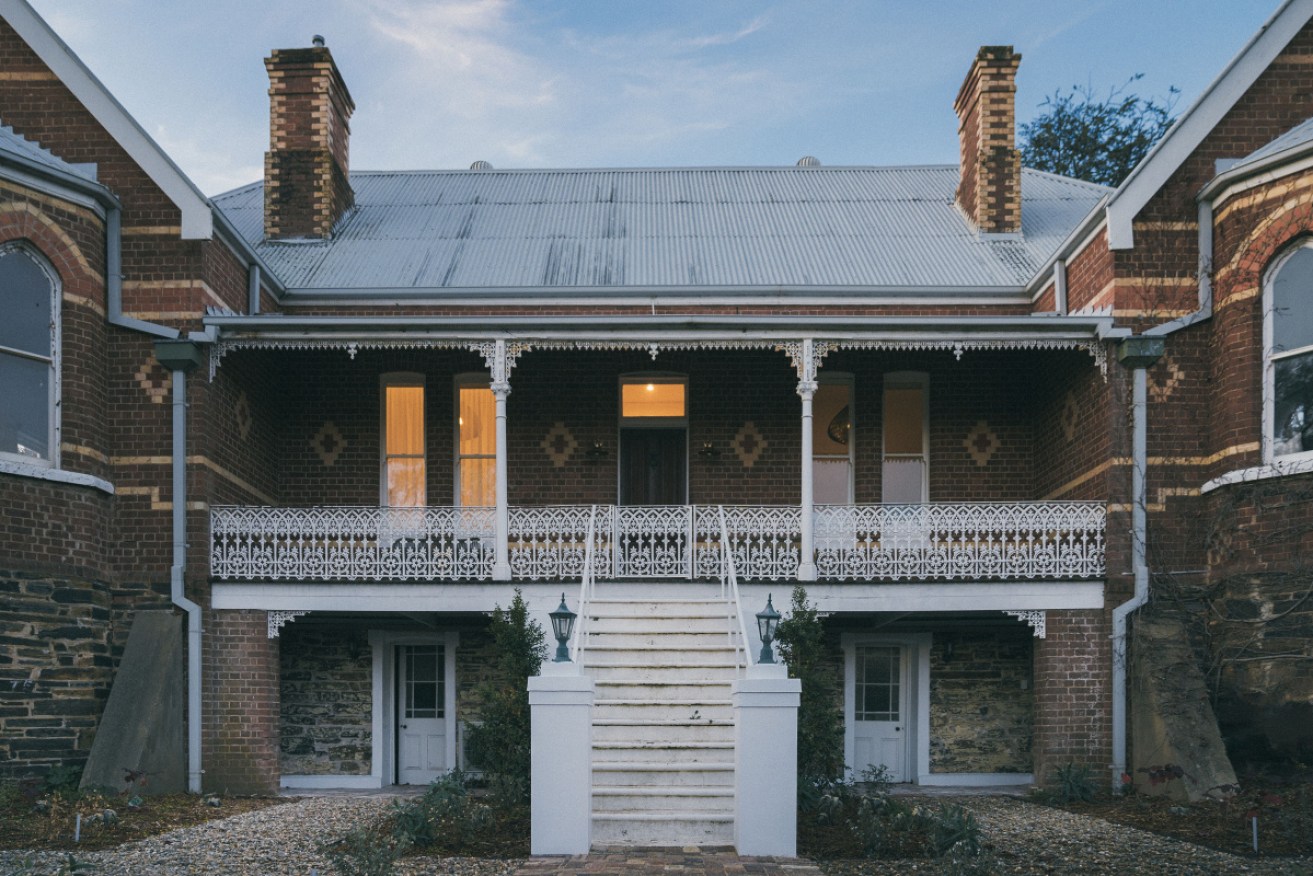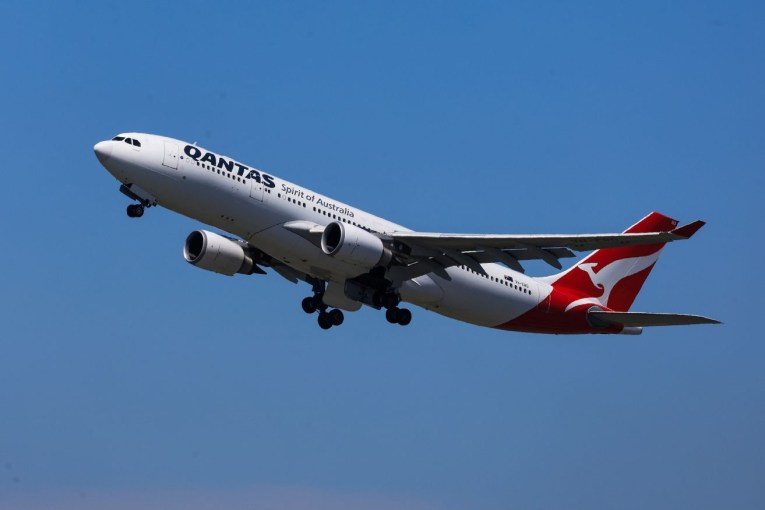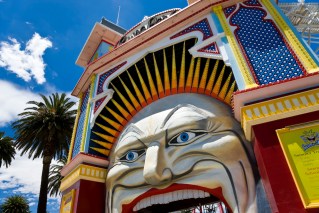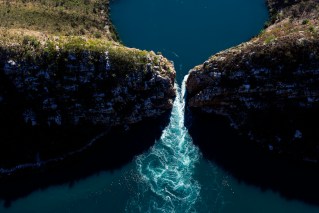From vintage shopping to boutique hotels: There’s more to historic Gundagai than the dog on the tuckerbox

Convent-turned-boutique hotel Flash Jacks is just one of the reasons to visit Gundagai. Photo: Declan Black
The car ride from Jugiong takes about an hour.
It’s the wrong road. Or, at least, not the usual way into Gundagai, a town that’s a dot point loitering above the Murrumbidgee River, midway between Melbourne and Sydney.
“Turn right there,” the publican at Jugiong’s Sir George Hotel directed, pointing at a distant line of poplar trees. “It’s the best bit of real Australia you’ll ever see.”
You never know where a wrong road leads but this track winds back past a parade of distractions. Rock, ‘roo, sheep, crow. Then it thwacks smack bang into an Australian landscape made hauntingly familiar in Jack O’Hagan’s celebrated 1920s folk song – ‘Along the Road to Gundagai’- popularised later by country legend Slim Dusty.
Seasonal rains have freshened the scene so, yes, ‘the blue gums are growin’, the Murrumbidgee’s flowin’, beneath the sunny sky’.
Ultimately, the dirt becomes bitumen leading into Gundagai, past a line of historic buildings painted in heritage colours on Sheridan Street. This is the archetypal Australian country town: fine curtilage on wide streets, the courthouse, the Criterion Hotel, the handsome 1929 theatre.

Gundagai is an archetypal Australian town. Photo: Destination NSW
The renowned Niagara Café is closed but sold recently to new owners with plans to get back to business closer to Christmas. It’s a gem of the golden era that appears much as it was when the Australian Prime Minister John Curtin arrived unannounced for a late-night platter of steak and eggs while on a wartime fund-raising mission. It would have been an extraordinary amalgamation of politics and pans in the kitchen that night, with two other future Prime Ministers, Ben Chifley and Arthur Fadden in the party.
On the opposite side of the street, in the window, there’s a vintage-shopper’s delight. It’s an enticing coral-coloured frock with an impossibly tight-nipped waistline.
The doors at Junque & Disorderly are shut but there’s a phone number displayed on the antique dresser inside. A man called John Glascott answers my call.
“John, I have fallen in love,” I confess. “What am I to do if your shop remains closed?”
“I’ll send Debbie up for you,” he responds.
By now, a mist is rolling up from the river flats, and the moon is rising over rolling hills. There’s a high heel clattering at brisk pace along the pavement. Debbie materialises under a streetlight in blond mop and red lips.
“This way,” she says, jangling a bunch of keys and heading down an alleyway. She unlocks a wooden door and swipes at a switch.
The light flickers on, then off, then ‘boom!’ It’s a glittering Aladdin’s Cave. Vintage furs are lined on racks as far as the eye can see. Clear plastic covers are draped over pert-breasted mannequins in pretty florals and nice dress/coat combos. I’m going to need a great hairdo for the clingy black and gold lame with the ostrich feather collar.
How long have we got?
Debbie Clarke is a trooper. She flings her couturier collection of just-so-perfect outfits over a hook in a dimly lit backroom where a slip of mirror is propped against the wall.
“This one is from Paris,” she says, offering one of a number of a box-ticking European designs that look never worn. “I’ll have to charge full price for that one – $80 – because I wore it 40 years ago and I’m a bit sentimental.”
Gundagai is sentimental too. The town heaves with tales of bush balladeers, drovers, shearers, ne’er-do-wells n’ do-gooders. There are bushrangers aplenty: the irrepressibly good humoured John Gilbert (‘always polite to women’ but shot after killing a police constable at Jugiong in 1865) and Captain Moonlite (hanged in Sydney in 1880 but reinterred in 1995 under a Gundagai gum so that his last wishes to lie beside his love – bushranger James Nesbitt – could be granted).
Photos tacked on street-side signs celebrate the remarkable highpoints in a place that’s always been an overnight stopping point for pioneers. In olden times, they were heading into the interior by bullock cart, but in the midst of COVID-19, they’re rushing to cross the NSW/Victorian border before it closes.
Some of these travellers are propped against the bar of The Criterion Hotel. They are distracted from their pints by the eerie wall murals (traded for board by artist Arnold St Claire in the 1960s) which depict the deadliest flood in Australia’s recorded history. Tormented victims float as green-tinged apparitions on the pub wall; their names recorded in golden letters on a memorial board.
Gundagai was a frontier town when the early European settlers, confounded by the ebb and flow of Australian rivers systems, failed to take the advice of the local Wiradjuri people not to settle on the alluvial flats of the Murrumbidgee River.
About midnight, on June 24, 1852, heavy rains created a raging torrent, a mile wide and 20 feet deep. The flood swept away buildings and left people clinging in trees to preserve life. Around 100 people drowned but two Indigenous men – Yarri and Jacky Jacky – rescued a third of the town in a bark canoe.

‘The great rescue of 1852’ by sculptor Darien Pullen. Photo: Destination NSW
The people of Gundagai celebrated this heroic feat in 2017 with a permanent memorial. There is pride here: what was endured; how they survived. The dramatic sculpture on Sheridan Street reminds that the iconic Dog on the Tuckerbox – about five miles out of town on the Hume Highway – is not the only reason to visit Gundagai.
Flash Jacks is another reason. It’s ‘an old-fashioned shack’ that’s actually an immaculately sleek boutique hotel commanding fine district views. It’s named after one of Banjo Paterson’s Gundagai shearers – remember the rousing chorus ‘All among the wool, boys, all among the wool; Keep your wide blades full, boys, keep your wide blades full …’ – but the building is more lavish than a shearing shed.
Flash Jacks was built in 1888 as a Catholic convent but bought and renovated by David Ferguson and his wife Emelia, who run the nearby historic events venue Kimo Estate (#instafamous hilltop off-grid eco-huts that are booked a year in advance).
Ferguson is a local farmer and entrepreneur who has always been captivated by history. “Gundagai has seen it all,” he reflects. “Boom and bust, drought and flood, cart and rail, racehorses, bushrangers, presidents and poets. It lived through its history when so many other Australian country towns have just fallen by the way.”
A high-ceilinged room, with a soft-cushioned window seat, is just reward for road-weary travellers who find their way at the end of the road to Gundagai.








